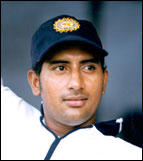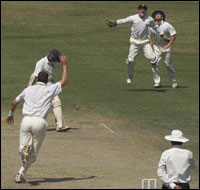


Prem Panicker
Start with March 1998, when Australia played India in the first Test in Chennai, and one statistic jumps out and hits you in the face: of 14 Tests played at home in the period between then and now, India have won five, drawn two, and lost an astonishing 7, giving us a win rate at home of a mere 35.71 per cent.
Why, then, at the start of every tour, have we been talking of how difficult it is to beat India in India?
The 7 losses, taken in conjunction with just two draws (do you remember a time when five-Test series used to be played at home, with scorelines reading played five, drew four, lost (or won) one?) get you to thinking. And delving deeper.
When you do, you find this (please note, for reasons I'll go into a bit later in the programme, I am only looking at the first innings): On an average, during the period in question, the number one batsman for India has scored 45.29, number two has scored 41.79, number three has weighed in with 52.93, number four scores 75.50, number five 36.43, number six 20.29 and even number seven contributes 16.92.
Look at it another way: During the same period, the average partnership for each wicket has been as follows: First wicket 60.36, second wicket 46.14, third wicket 60.71, fourth wicket 59.93, fifth wicket 40.93, and sixth wicket 30.23.
 Here is another statistic -- if you look at the various players who have played in positions one to six, and find out which of them has the highest average for his particular position, you find that S Ramesh has been our best at number two with an average of 42.67, Dravid at three has an astonishing 60.17 average (12 innings), Tendulkar at four does even better with 79.46 (13 innings), and Ganguly, at six, can boast of 30.40 (5 innings). We haven't had a consistent number one, and the other absentee from the list is Azharuddin at number five, averaging 52.67 over six innings.
Here is another statistic -- if you look at the various players who have played in positions one to six, and find out which of them has the highest average for his particular position, you find that S Ramesh has been our best at number two with an average of 42.67, Dravid at three has an astonishing 60.17 average (12 innings), Tendulkar at four does even better with 79.46 (13 innings), and Ganguly, at six, can boast of 30.40 (5 innings). We haven't had a consistent number one, and the other absentee from the list is Azharuddin at number five, averaging 52.67 over six innings.
Statistically, India seems to have done well, individually and collectively. In other words, we do well, individually and collectively. The current team has four batsmen in the top six boasting more than decent averages. So do tell, with those kind of figures, that too for the first innings, how in heck did this team manage to win only six while losing twice as many?
The answer lies in another set of stats entirely: During this same period, during the 14 Tests in question, India has been shot out under 90 overs 5 times in the first innings. Surprise, surprise -- on each of those occasions, the team has lost. (Check out Mohandas Menon's table for full details).
Why the 90-overs yardstick? There was a time when Tests were thought of -- by fans and tacticians alike -- as being five-day games. That changed, the day the rule mandating 90 overs in a day was introduced. Since then, it has become more appropriate to think of a Test as being a 450 over game, spread over five days.
This also means that 'one day' as we used to know it then, has now become '90 overs'. If a team doesn't bat out 90 overs, what we are really saying is that 11 players between them couldn't last out three sessions.
When you fail to do that, what you give the opposition is the gift of time. And overs to play with. Thus, time and again, India has been shot out inside a 'day's play'. And has managed to put the opposition under pressure in the early stages of the reply -- only to see them get away towards the end.
One major reason for this is the fact that the opposition has time on its hands, and overs. Thus, if they have a bad first session, they know that in the second session they can focus on regrouping, gradually batting themselves back into the game without worrying too much whether they put runs on the board -- all they need to do is hang in there, even at the expense of time and overs, till they get a second wind.
A major part of Test match strategy thus has to be to deny the opposition that space, that time, those overs. Getting shot out before the second new ball is taken is not, therefore, the way to go.
Has India, as a team, forgotten the art of Test batting? The consensus among analysts seems to be that India lost the first Test, at the Wankhede, when Ricky Ponting took that astonishing catch to halt Sachin Tendulkar, then in full flow, in the second innings.
 Really? Read the match reports of the first day of that Test. Notice the common refrain? Patience, or the lack thereof, leads to the undoing of Ramesh, tempted to hook wildly at a ball sailing down the leg side. Of Das, who after being set, played a drive with bat well away from body at a nothing ball from Gillespie. Of Laxman, again fishing outside off at McGrath at a time when the bowler was focussing on line and length in an attempt to contain the scoring. Of Sachin, driving without quiet being there at McGrath. Javagal Srinath, heaving across the line; Harbajan Singh, ditto. Sanghvi, driving away from body at Gillespie.
Really? Read the match reports of the first day of that Test. Notice the common refrain? Patience, or the lack thereof, leads to the undoing of Ramesh, tempted to hook wildly at a ball sailing down the leg side. Of Das, who after being set, played a drive with bat well away from body at a nothing ball from Gillespie. Of Laxman, again fishing outside off at McGrath at a time when the bowler was focussing on line and length in an attempt to contain the scoring. Of Sachin, driving without quiet being there at McGrath. Javagal Srinath, heaving across the line; Harbajan Singh, ditto. Sanghvi, driving away from body at Gillespie.
That makes seven batsmen out playing shots they had no business playing in a Test match -- shots they just might have got away with in the second half of a one-day innings, once the close fielders had backed off and the bowling side had settled down to the job of run-restriction.
Given that performance, Australia did not have to wait for Ponting to take the catch -- they won the game once they bundled India out inside of a measly 71.3 overs.
Sure, Australia's own innings lasted only slightly longer (73.2 overs). But in that time, they doubled India's tally, and that was enough to make sure of the result. India's tragedy is that it fell between two stools -- unable to bat for long periods, nor yet able to rattle the runs up at an alarming pace. And by getting India into the second innings with close to 302 overs left to play, ensured that the home side could not even think of playing for a draw (as Indian teams of the 70s and 80s have so often managed).
Consider, in contrast, one of India's finer wins, at home, against the Aussies in recent times -- the first Test of the 1998 series, in Chennai. In the first innings, India bats through 104.2 overs -- putting just 257 on the board, at slightly over two runs per over, but having shut the door a bit on the Aussies were time and overs were concerned. And in the second innings, India then steps it up -- batting for 107 overs, but scoring a crackling 418/4 declared to set up the win.
The length -- or lack thereof -- of the Indian innings proved to be a decisive factor in Bombay. As it has been, throughout a period wherein the home side lost its reputation for invincibility in home conditions.
That same factor is likely to prove decisive in Calcutta -- a short first innings, and nothing short of a miracle will stop Australia from taking the series 2-0 when they leave the Gardens.
Illustration: Dominic Xavier
Read also:
• Time to kill
• All about the Venues
Prem Panicker
Mail Prem Panicker